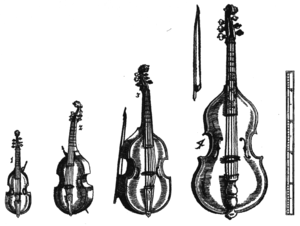Viol
|
|
The viol or viola da gamba family of musical instruments is related to the vihuela, rebec, etc.
The instrument has its roots in the guitar and the rebec; it is thought that guitarists began playing their instruments with a bow in the 15th century. This eventually led to the evolution of an entirely new instrument, which had many of the features of the guitar (flat back, frets), but was bowed rather than plucked. This new instrument was at first held in the same way as a guitar, but later began to be held upright, either resting on the lap or held between the legs like a cello, giving it the name viola da gamba, Italian for "viol of the leg."
Some texts have stated that the gamba was a forerunner to the violin family, but there is no historical evidence for this at all. The violin had entirely different origins, and during the Renaissance it was thought to be a very inferior instrument to the viol.
The viol is fretted, like a guitar (although with moveable, tied-on frets made of gut), and usually has six strings, though examples with only five strings do exist. A low seventh string (A'') was added in France by the Monsieur de Sainte-Colombe, who taught many of the French gamba virtuosi of the 18th century. Unlike members of the violin family, which are tuned in fifths, the gamba is tuned in fourths and one third in the middle, mirroring the tuning employed on the lute during the sixteenth century and similar to that of the modern guitar. The bow is held underhand and is generally convex rather than concave like a modern violin bow.
The gamba (as the name is often abbreviated for convenience) comes in 6 sizes: "pardessus de viole" (which is relatively rare), treble, alto, tenor, bass, and double bass (also known as a violone). The treble is about the size of a violin (but with a deeper body); the bass is a bit smaller than a cello. A closely related instrument is the viola d'amore, although the viola d'amore is played under the chin, viola-fashion.
The standard tuning of the viol is in 4ths, with a 3rd in the middle (like the standard Renaissance lute tuning). For treble and bass viols the notes would be (from the highest) d',a,e,c,G,D and for the tenor g,d,A,F,C,G'. The treble is one octave higher than the bass. Other tunings were employed, particularly in the solo lyra viol style of playing, which also made use of many techniques such as chords and pizzicato (i.e. plucking rather than bowing the strings), which were not generally used in consort playing. An unusual style of pizzicato was known as a thump. Lyra viol music was also commonly written in tablature, and there is a vast repertoire of this music, some by well-known composers, but a lot of it anonymous.
The instrument was common among amateurs, and many homes would have a so-called chest of viols which would contain one or more instruments of each size. Gamba ensembles, called consorts, were common in the 16th and 17th centuries, when they performed vocal music (consort songs or verse anthems) as well as that written specifically for instruments. Music for consorts was very popular in England in Elizabethan times, with composers such as William Byrd, John Dowland and during the reign of King Charles I by composers such as John Jenkins and William Lawes. The last music for viol consorts before their modern revival was probably that written in the early 1680s by Henry Purcell.
Viola_da_Gamba_Isenheimer_Altar.png
There are several important treatises concerning the viol. The first was by Silvestro Ganassi: Regola Rubertina & Lettione Seconda (1542/3). Diego Ortiz published Trattado de Glosas (Rome 1553), an important book of music for the viol with both examples of ornamentation and pieces called Recercadas. In England, Christopher Simpson wrote the most important treatise, with the second edition being published in 1667 in parallel text (English and Latin). This has divisions at the back which are very worthwhile repertoire. A little later in England, Thomas Mace wrote Musick's Monument, which deals more with the lute, but also has an important section on the viol. After this the French treatises by Rousseau, Danoville (1685) and Loulie (1700) show further developments in playing technique.
The bass viola da gamba continued to be used (as a solo instrument and also to accompany the harpsichord in basso continuo) into the 18th century, by which time it had acquired associations of courtliness and antiquity; composers such as Marin Marais, Johann Sebastian Bach and Karl Friedrich Abel wrote music for it. However, the instrument fell out of use as concert halls grew larger, and the louder and somewhat more strident tone of the violin family became more popular. In the last one hundred years or so, the viola da gamba has been revived by early music enthusiasts, an early proponent being Arnold Dolmetsch.
The film Tous les Matins du Monde by Alain Corneau is based on the life of the Monsieur de Sainte-Colombe and Marin Marais, prominently featuring their music for the viol da gamba. The film soundtrack features performances by Jordi Savall, perhaps the best-known modern viola da gamba player.de:Viola da Gamba eo:Gambovjolo fr:Viole de gambe hu:Viola da Gamba nl:Viola da gamba ja:ヴィオラ・ダ・ガンバ fi:Viola da gamba sv:Gamba

